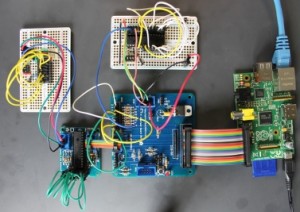Microwriter revisited
I'm taking a break from Test Equipment, and resuming a project that has been on hold for a couple of years.
It's a home brewed compact one-hand chorded keyboard inspired by the Microwriter.
I started the project using an Atmel ATMega8 hosted on SimmStick hardware. My tools for software development were primitive. WinAVR was still in its infancy, so like most Atmel developers I used AVR Studio and programmed in assembler or programmed in BASIC using Bascom from MCS Electronics.
I decided to use I2C to connect the micro controller to the keypad and LCD display. Driving I2C in assembler was a pain, and writing the keyboard handling in Basic was positively soul-destroying. I decided to wait until technology had improved enough to make the project enjoyable.
Fast forward two years. The Arduino offers an affordable hardware platform and an easy-to-use IDE. The main challenge is the keyboard itself; I'm going to experiment with QTC pills which look perfect for this sort of application.
Once I've put together a prototype keyboard I can drive it using an I2C board, an Arduino and an I2C LCD display. I'll use the I2C data logger to hold text.
It's a home brewed compact one-hand chorded keyboard inspired by the Microwriter.
I started the project using an Atmel ATMega8 hosted on SimmStick hardware. My tools for software development were primitive. WinAVR was still in its infancy, so like most Atmel developers I used AVR Studio and programmed in assembler or programmed in BASIC using Bascom from MCS Electronics.
I decided to use I2C to connect the micro controller to the keypad and LCD display. Driving I2C in assembler was a pain, and writing the keyboard handling in Basic was positively soul-destroying. I decided to wait until technology had improved enough to make the project enjoyable.
Fast forward two years. The Arduino offers an affordable hardware platform and an easy-to-use IDE. The main challenge is the keyboard itself; I'm going to experiment with QTC pills which look perfect for this sort of application.
Once I've put together a prototype keyboard I can drive it using an I2C board, an Arduino and an I2C LCD display. I'll use the I2C data logger to hold text.



Well? What happened? I'd love to do this but am too busy...
ReplyDeleteThe keyboard was the problem. I eventually built one using microswitches, and it worked, but was literally too painful to use.
ReplyDeleteThese days I'd probably use capacitive sensors. I may resurrect this some day, but I have other projects stacked up for the foreseeable future.
Interesting. The clicky keyboard was a great strength of the old microwriter, but used to enrage my neighbours.
ReplyDeleteIf I was making one now I'd use a glove with piezo sensors...
Hi Romilly,
ReplyDeleteI built a microwriter style keyboard for a project to aid a disabled person some years back based on a PIC. I found some nice rocker style keyswitches that are easy on the finger tips. I must also resurect this project and base it on the Arduino or Pi.